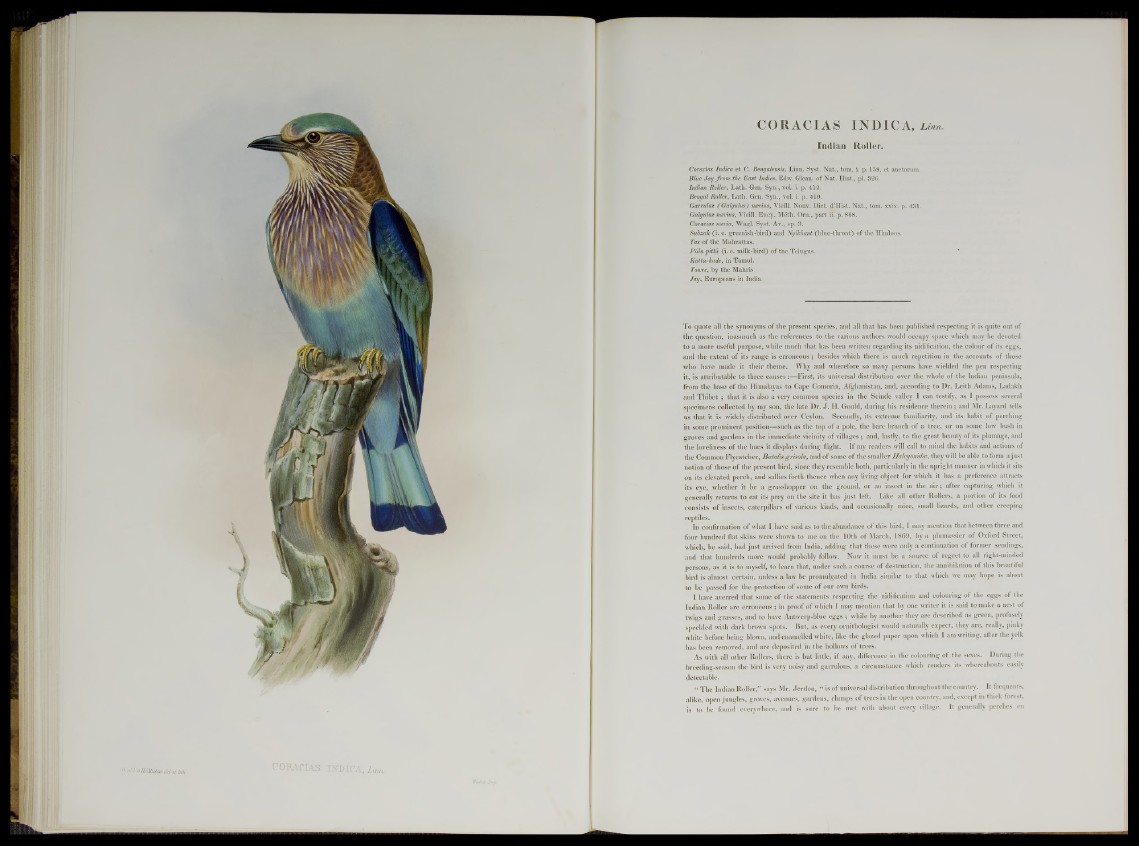
¿ fyJIC R uhia; d d e b litív
CORACIAS INDICA, Linn.
In d ia n Roller.
Coradas Indica et C. Bengalensis, Linn. Syst. Nat., tom. i. p. 159, et auctorum.
Blue Jay from, the East Indies, Edw. Glean, of Nat. Hist., pi. 326.
Indian Roller, Lath. Gen. Syn., vol. i. p. 412.
Bengal Roller, Lath. Gen. Syn., vol. i. p. 410.
Gárrulos ( Galgulus) nodus, Vieill. Nouv. Diet. d’Hist. Nat., tom. xxix. p. 431.
Galgulus nodus, Vieill. Ency. Méth. Orn., p art ii. p. 868.
Coradas novia, Wagl. Syst. Av., sp. 3.
Subzak (i. e. greenish-bird) and Nyllchant (blue-throat) of the Hindoos.
Tas'of the Mahrattas.
Pálu pittá (i. e. milk-bird) of the Telugus.
Katta-kade, in Tamul.
Towee, by the Mahris.
Jay, Europeans in India.
To quote all the synonyms of the present species, and all that has been published respecting it is quite out of
the question, inasmuch as the references to the various authors would occupy space which may be devoted
to a more useful purpose, while much that has been written regarding its nidification, the colour of its eggs,
and the extent of its range is erroneous ; besides which there is much repetition in the accounts of those
who have made it their theme. Why and wherefore so many persons have wielded the pen respecting
it, is attributable to three causes:—First, its universal distribution over the whole of the Indian peninsula,
from the base of the Himalayas to Cape Comorin, Afghanistan, and, according to Dr. Leith Adams, Ladakh
and Thibet ; that it is also a very common species in the Scinde valley I can testify, as I possess several
specimens collected by my son, the late Dr. J. H. Gould, during his residence therein ; and Mr. Layard tells
us that it is widely distributed over Ceylon. Secondly, its extreme familiarity, and its habit of perching
in some prominent position— such as the top of a pole, the bare branch of a tree, or on some low bush in
groves and gardens in the immediate vicinity of villages; and, lastly, to the great beauty of its plumage, and
the loveliness of the hues it displays during flight. If my readers will call to mind the habits and actions of
the Common Flycatcher, Butalis grisola, and of some of the smaller Halcyonidce, they will be able to form a just
notion of those of the present bird, since they resemble both, particularly in the upright manner in which it sits
on its elevated perch, and sallies forth thence when any living object for which it has a preference attracts
its eye, whether it be a grasshopper on the ground, or an insect in the air; after capturing which it
generally returns to eat its prey on the site it has just left. Like all other Rollers, a portion of its food
consists of insects, caterpillars of various kinds, and occasionally mice, small lizards, and other creeping
reptiles.
In confirmation of what I have said as to the abundance of this bird, I may mention that between three and
four hundred flat skins were shown to me on the 10th of March, 1869, by a plumassier of Oxford Street,
which, he said, had just arrived from India, adding that these were only a continuation of former sendings,
and that hundreds more would probably follow. Now it must be a source of regret to all right-minded
persons, as it is to myself, to learn that, under such a course of destruction, the annihilation of this beautiful
bird is almost certain, unless a law be promulgated in India similar to that which we may hope is about
to be passed for the protection of some of our own birds.
I have averred that some of the statements respecting the nidification and colouring of the eggs of the
Indian Roller are erroneous ; in proof of which I may mention that by one writer it is said to make a nest of
twi°'s and grasses, and to have Antwerp-blue eggs ; while by another they are described as green, profusely
speckled with dark brown spots. But, as every ornithologist would naturally expect, they are, really, pinky
white before being blown, and enamelled white, like the glazed paper upon which I am writing, after the yelk
has been removed, and are deposited in the hollows of trees.
As with all other Rollers, there is but little, if any, difference in the colouring of the sexes. During the
breeding-season the bird is very noisy and garrulous, a circumstance which renders its whereabouts easily
detectable.
“ The Indian Roller,” says Mr. Jerdon, “ is of universal distribution throughout the country. It frequents,
alike, open jungles, groves, avenues, gardens, clumps of trees in the open country, and, except in thick forest,
is to be found everywhere, and is sure to be met with about every village. It generally perches on